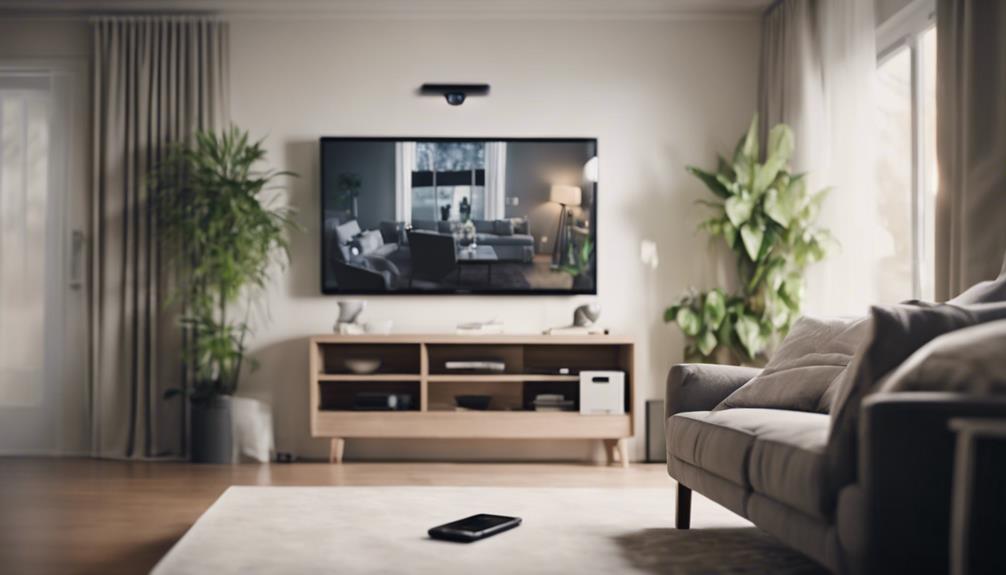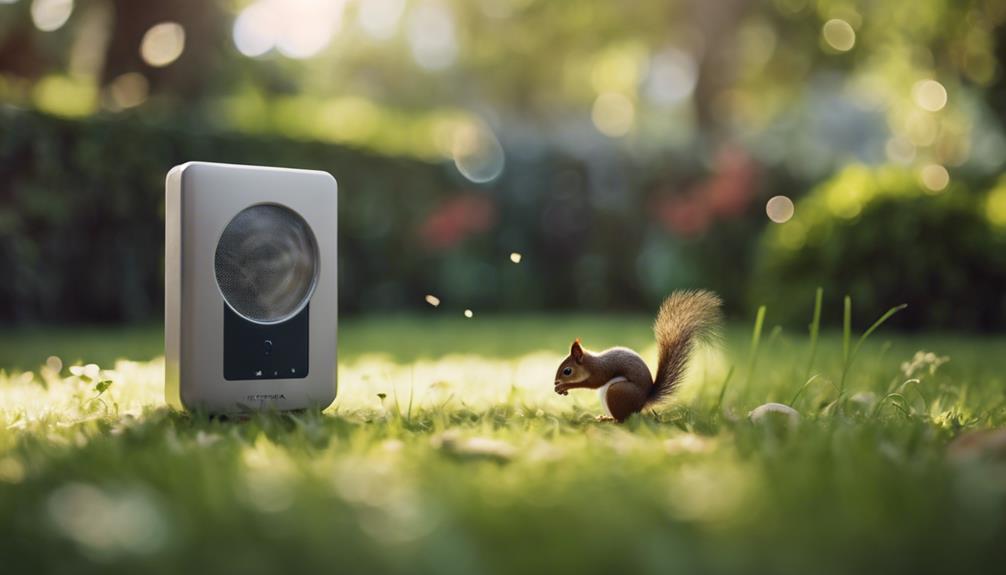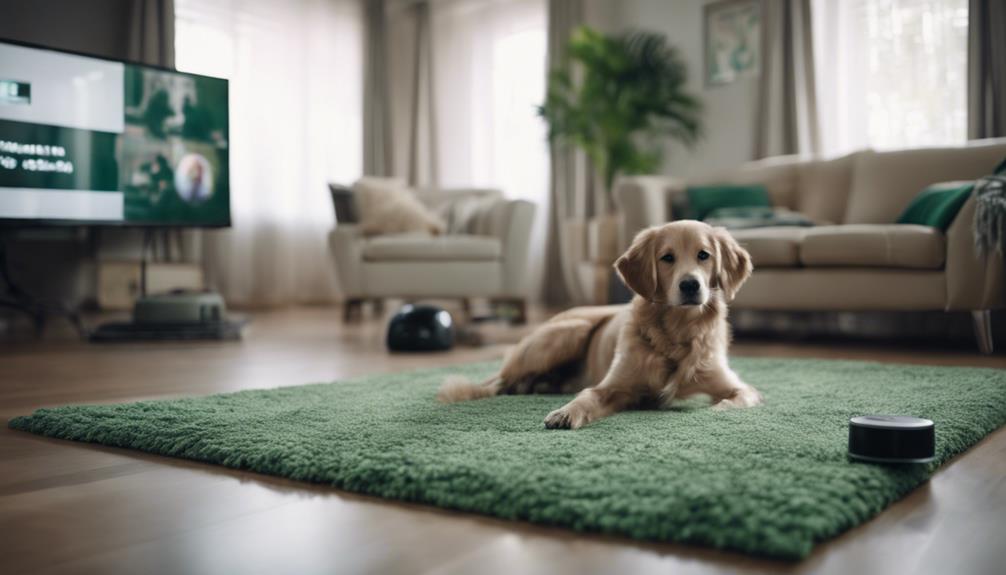
Brainstorm Security Shop

For Orders Over $199

On Any Of Our Products

Details On Refund Page
Have you ever wondered how a home security system can tell the difference between your playful pup and an actual intruder? With pet detection technology, you’re equipped with tools that not only secure your home but also allow your pets to roam freely without triggering false alarms. These systems utilize advanced algorithms and sensitivity settings tailored to the size and behavior of various animals. Now, consider the peace of mind and convenience this could bring to your daily life. Yet, one might ask, how reliable are these systems when faced with the unpredictability of pet movements and behaviors? Let’s explore.

Pet detection technology zeroes in on distinguishing between your furry friends and potential intruders, ensuring your home security system ignores animal movements. You might wonder how it works.
Essentially, this tech uses advanced algorithms that analyze movement patterns and body shapes. It differentiates a cat slinking around the corner from a person attempting to sneak through a window.
When you’re not home, the last thing you want is a barrage of notifications every time your pet moves. Without this technology, your system can’t tell the difference between your dog jumping on the couch and someone breaking in. That’s where pet detection comes in handy. It smartly filters out the everyday activities of your pets, so you’re only alerted when there’s a real threat.
This capability not only reduces the number of false alarms but also saves you the hassle of constantly checking your phone. You can relax knowing that your security system is sophisticated enough to recognize the members of your family—whether two-legged or four—and focus on keeping the real threats at bay.
With this tech, you get peace of mind, knowing that your pets won’t trigger unnecessary alarms.
Now that you understand how pet detection technology works, let’s explore the key features of pet-friendly home security systems. These systems are designed to distinguish between your pets and potential intruders, reducing false alarms significantly.
Firstly, adjustable sensitivity settings are crucial. You can set the system’s sensitivity to ignore movements from smaller pets like cats or small dogs, focusing instead on larger movements that could signify a human intruder. This customization ensures that your pet’s normal activity won’t trigger an alarm.
Secondly, look for systems with smart cameras equipped with advanced motion sensors that differentiate between animals and humans based on size, shape, and movement patterns. These cameras often integrate with your smartphone, allowing you to monitor your home and pets remotely.
Another essential feature is the use of pet-immune motion detectors. These detectors can be programmed to overlook animals under a certain weight limit, ensuring that your furry friends can roam freely without setting off alarms.
Lastly, consider systems that offer integration with other smart home devices. This allows for more comprehensive management of your home’s security and automation, adapting seamlessly to your and your pet’s daily routines.
Integrating pet detection in your home security system offers numerous benefits, including enhanced accuracy and reduced false alarms. You’ll find peace of mind knowing that your system can distinguish between your pet moving around and an actual intruder. This specificity not only minimizes interruptions but also saves you from unnecessary stress and potential costs associated with responding to non-threats.
Moreover, this tailored approach allows you to keep your security settings activated even when your pets are home alone. There’s no need to deactivate your alarms, which enhances continuous protection of your property. You can confidently leave your furry friends roaming freely, knowing that your security system is smart enough to watch over them without any hiccups.
Another standout advantage is the potential for lower insurance premiums. Insurance companies often recognize the added reliability of pet-friendly security systems and might offer discounts. This reduction in premiums can make investing in a sophisticated system more appealing and economically feasible.
Lastly, you’ll enjoy a more adaptable security solution. Contemporary pet detection systems can be adjusted to recognize different sizes and breeds of pets, ensuring that your system grows with your pet family. This flexibility makes it an ideal choice for animal lovers looking to secure their homes effectively.
While considering the installation of a pet-friendly security system, it’s essential to follow specific tips to ensure optimal functionality and ease of use. First, you’ll want to choose the right location for cameras and sensors. Place them where your pet frequents, but high enough to avoid accidental tampering or damage. It’s also wise to angle cameras away from places where your pets might cause false alarms, like near a feeding station or a favorite napping spot.
Next, adjust the sensitivity settings of your system. Most modern systems allow you to tweak motion detection sensitivity to differentiate between pet movements and human intruders. You’ll need to experiment with these settings to find the right balance that minimizes false alarms without compromising security.
Don’t forget to test your system thoroughly after installation. Walk through the areas covered by your security system with your pet to see how it reacts to both of your movements. You might need several adjustments during the initial setup to get everything just right.
Lastly, consider integrating smart home features that complement your pet-friendly system. Features like remote monitoring and control can enhance security while also making it easier to check in on your pets when you’re away.

Let’s compare some of the top pet detection models to find the best fit for your home security needs. You’ll want to consider features like sensitivity settings, camera resolution, and the system’s ability to distinguish between pets and potential intruders.
First up, we’ve the WhiskerGuard Pro. It’s known for its high-definition cameras and adjustable sensitivity levels, ensuring that your cat or dog won’t trigger an alarm every time they stroll by. It’s ideal if you’ve got a particularly active pet.
Next, consider the PawsSecure Max. This model offers a unique feature—thermal imaging—to accurately detect the size and the heat signature of moving objects. This means it’s less likely to mistake a small dog for a burglar, making it a solid choice for mixed pet homes.
Lastly, the FurFortress 360 stands out with its all-around coverage. It boasts a 360-degree camera rotation, capturing every corner of your home. This is perfect for you if you’re worried about blind spots where your pets might hide or play.
Each of these models has its strengths, so you’ll need to weigh what’s most important: camera quality, sensitivity, or coverage. Choose wisely to keep both your home and your furry friends safe.
You might encounter a few common issues when setting up or using your pet detection system. One frequent problem is false alarms. If your system’s sensitivity is set too high, it might mistake minor movements, like curtains swaying, for your pet. Try adjusting the sensitivity settings to better distinguish between everyday movements and genuine alerts.
Another issue could be the placement of cameras or sensors. If they’re positioned too low or at an angle where pets frequently pass, you’ll get constant notifications. Rethink your camera placements to areas where your pets rarely go or adjust the angle to minimize unnecessary triggers.
Connectivity issues are also common. If your system often loses connection or doesn’t send alerts as expected, check your home’s Wi-Fi strength near the device locations. You might need to move your router or invest in a Wi-Fi extender to ensure stable connectivity across your home.
Lastly, don’t overlook software updates. Outdated firmware can lead to performance issues. Ensure your system’s software is up-to-date to fix bugs and improve functionality. Regular checks for updates can save you a lot of hassle in the long run.

To enhance your system’s accuracy, you should consider refining the placement of sensors and cameras. It’s key to position sensors where your pets usually don’t roam but intruders might. For instance, placing motion sensors at heights where your pets can’t trigger them but a human would, like above door frames, can drastically reduce false alarms.
You’ll also want to adjust the sensitivity settings of your system. Many modern security systems allow you to customize the sensitivity of motion detectors. By setting these to a higher threshold, your pets won’t set them off unless they do something out of the ordinary, like jumping high.
Furthermore, investing in cameras with advanced motion detection technology, such as those with artificial intelligence that can differentiate between animals and humans, will further enhance accuracy. Make sure these cameras have a clear field of view and aren’t obstructed by furniture or decorations.
Regularly updating your system’s software ensures that you benefit from the latest improvements in pet detection algorithms. Manufacturers often release updates that improve the system’s ability to distinguish between pets and potential threats, which can help in minimizing the likelihood of false alarms.
Looking ahead, the future of pet detection in home security systems is set to become even more sophisticated and integrated. You’ll soon see technologies that not only distinguish between humans and pets but also identify your pets by name. Imagine your security system greeting your dog, Max, by name as he lounges in the living room while you’re at work. This is possible through advancements in facial recognition technology tailored specifically for pets.
You’ll also experience a surge in mobile integration, allowing you to receive real-time updates about your pet’s activities. If your cat, Whiskers, jumps on the kitchen counter, you’ll get an alert directly on your smartphone. This isn’t just about keeping them off the furniture; it’s about ensuring their safety when you’re not around.
Moreover, future systems will likely incorporate health monitoring features. Your home security system could alert you to changes in your pet’s behavior that may indicate illness or distress. This means not only keeping your home secure but also fostering a healthy environment for your furry friends.
These innovations will make your life easier and give you peace of mind, knowing that your pets are safe and sound, even when you’re away.

As you explore the world of home security with pet detection, you’re investing in peace of mind. Whether you’re setting up your system or choosing the right model, remember customization is key to accommodate your furry friends.
Embrace the latest technology to enhance accuracy and stay ahead of future trends. With these tools, you’ll not only secure your home but also ensure your pets are safe and sound, making your life worry-free and simpler.

Brainstorm Security Shop
1867 Caravan Trail
Ste 105
Jacksonville, FL 32216
Call us toll free: (800) 859-5566